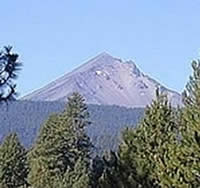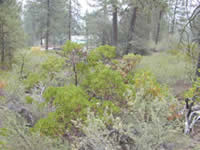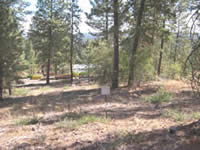Healthy Forests Success Story
Ninemile Timber Sale and Natural Fuels Reduction Project
Fremont-Winema National Forests
July 2009
Project Description

Fremont-Winema National Forests scene.
The Fremont-Winema National Forests designed the Ninemile Timber Sale and Natural Fuels Reduction Project to reduce fire hazards and improve overall forest health and vigor. Located on the Chiloquin Ranger District in Southern Oregon, the National Forest stands are composed mainly of a mixture of large, old growth ponderosa pine and smaller, younger trees.
It has been over eighty years since the last natural burn occurred in the area due to fire suppression. This has created a hazardous accumulation of fuel loadings and greater risk of uncontrollable fires.
Through the Ninemile Project, the fire hazard has been significantly reduced by commercial and pre-commercial thinning, piling and burning, mastication, and prescribed under-burning. Initial planning for the project began in 2003. Then in 2004, it was converted into the first Healthy Forest Restoration Act (HFRA) project in the region. Currently the project is in its final implementation stages.
Collaboration Success
The Ninemile Project, altogether with the Ninemile North and Chiloquin Community Fuels Projects, received regional recognition through the "Caring for the Land" award. All of the projects were greatly supported by local citizens, the Klamath Tribes, the Chiloquin Community Action Team, a rural fire department and some environmental groups. Examples of collaborative efforts included:
- Locally interested parties were involved early on in the process, and Forest staff focused on community protection and on employing a full range of treatments.
- The project received full participation by the Klamath Tribes who retain treaty rights to their former reservation lands on the Fremont-Winema National Forests. The Tribes agreed on the importance of preventing a catastrophic fire event and wanted to make sure big game habitat was enhanced. With a large local population base, the Klamath Tribes served as one of the projects main collaborators and helped guide the initial goals of the project.
Lessons Learned
- Additional funding from the Secure Rural Schools Act and other appropriated funds were needed, especially in the case of the Ninemile Project in which the value of saw-logs was not enough to fund more than a small portion of post-sale work such as whip-falling, slash-busting and under-burning, or any of the fuel reduction efforts outside of harvest units.
- The objection process is a useful tool that allowed Forest Service staff to talk with parties more informally to resolve concerns rather than going through a formal appeals process.
- Some collaborators may be hesitant to use HFRA because it is new and different. It can help when collaborative partners understand fire behavior and the importance of fuel reduction projects.
For More Information
Contact Fremont-Winema National Forest
Kevin Moore, Timber Program Manager
Fremont-Winema National Forests
(541) 883-6755
krmoore@fs.fed.us

